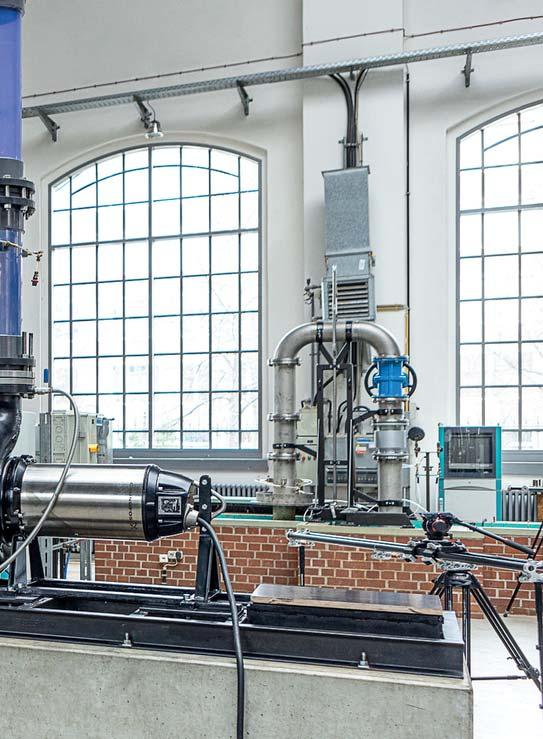
4 minute read
Digital Twin in Wastewater Treatment
from CITY:ONE.1.2020.EN
by CityOne
The experimental pumping station works on a closed loop at TU Berlin, in order to simulate a variety of real-life scenarios, virtualized and operated in digital twin model. Credit: TU Berlin/Siemens AG

Advertisement
DIGITAL TWIN TECHNOLOGY LINKS ASSET MANAGEMENT, MODELLING & SIMULATIONS AND REAL DATA STREAMS, EMPOWERING PROFESSIONALS ACROSS DIVERSE DEPARTMENTS TO MAKE BETTER DECISIONS BASED ON BETTER FORECASTS, PRIORITISE CAPITAL PLANNING AND OPTIMIZE OPERATIONS.
The current data surplus stemming from all types of devices together with boosting computer capacity is revolutionizing almost all existing sectors, and the water sector will not be the exception. The development of new holistic approaches nowadays uncover the potential of linking the wastewater treatments operation strategies to smart grids electricity systems.
: The fourth-revolution in the water sector
Combining the power of big data analytics with existing and future urban water infrastructure represents a signifi cant untapped opportunity for operation, maintenance, and rehabilitation of urban water infrastructure to achieve economic and environmental sustainability. Although there are divergent views about the potential of big data analytics to disrupt the water sector, there is little doubt it will change progressively, and inevitable, the way we think and provide infrastructure services in urbanized areas. An estimate 80% of the utilities in developed countries are expected to undergo a digital transition, to some extent, by 2025.In North America and Western Europe, where extensive infrastructure systems already exist, markets for digital technologies are emerging to address the issues associated with aging infrastructure. Overall, a study by Global Water Intelligence predicts global demand for control and monitoring solutions will rise to USD 30.1 billion by 2021, a market that utilities with pre-existing digital platforms will be better prepared to embrace.
To further highlight the potential of incorporating digital technologies intothe water sector, reference can be made to the energy sector’s adoption of microgrids and smart-sensing to reduce vulnerability of large-scale plantsto climate eff ects, decrease operational complexity, and provide resiliency, reliability, fl exibility and redundancy to the sector. These benefi ts can also be seen through establishing micronets (water microgrids – decentralised water and sanitation systems) coupled to local distribution networks. By downscaling plants and treatment facilities to serve smaller regions, monitoring and maintenance becomes easier and less costly, and the installation of new digital technologies is more realistic.
: Digital Twin in TU Berlin
The Berlin Technical University (TU Berlin, Germany) has created recently the most advanced digital twin of 1:1 scale pumping station in the country wastewater sector and most probably one of the most consistent database of each component virtually connected to each other globally, as a research and demonstration project. The main purpose is to study the operation optimization and blockage prediction using a digital twin data in full-scale. The target point was a single digital environ-
ment for all pump station information, from design to operation and maintenance data, including partially autonomous systems for fault detection and elimination. The bidirectional data exchange between process engineering software (for design and asset management) and process control system (for operation and modelling) ensures that the information is up to date throughout the entire operating phase.
: Casestudy coupling SmartGrids and Wastewater Treatment
In the City of Kolding (Denmark), an integrated model predictive control (MPC) strategy to control the power consumption and theeffl uent quality of a municipalwastewater treatment plant by utilizing the storage capacity from the sewer system was implemented.
Wastewater from the Kolding urban area is conveyed to a pumping station, which pumps it to the 125,000 Population Equivalent located 8 km away. There are 21 storage basins spread across the catchments, with a total storage volume of 30.000 m3. The maximum power capacity for the biological wastewater treatment process is 720 kW, and aeration is responsible for at least 60% of the power consumption of the plant. The plant electricity bill is currently paid via a retailer, EnergiDanmark, and a small part of the price changes every hour. This hourly price is known 12 to 36 hours ahead and originates from the power exchange NordPools day-ahead market. The estimated yearly consumption of the Kolding is 2.7 GWh.
The developed price-based model reacted to electricity prices and forecasted pollutant loads 24 hours ahead. The large storage capacity available in the sewer system directly upstream from the plant was used to control the incoming loads and, indirectly, the power consumption of the treatment plant during dry weather operations. The model balances electricity costs and treatment quality based on linear dynamical models and predictions of storage capacity and effl uent concentrations and quality. The monetary savings of the MPC strategy for this specifi c case in Kolding plant were quantifi ed around approximately 200 DKK per day when fully exploiting the allowed storage capacity. Although the application to the specifi c Kolding system is not providing as great savings in monetary terms as expected, the structure of the proposed holistic approach enables an easy application in any other catchment. Hence this provides an important contribution towards the integration of municipal wastewater treatment and sewer system operation in electric smart grids in urban areas.

Water Sci Technol. 2020 Apr;81(8):1766-1777. doi: 10.2166/wst.2020.266.










